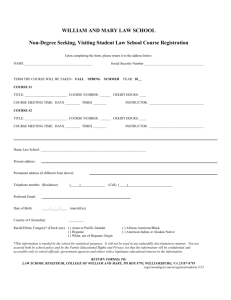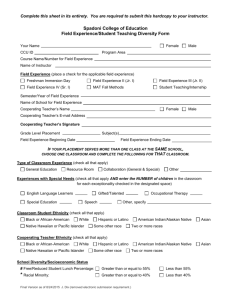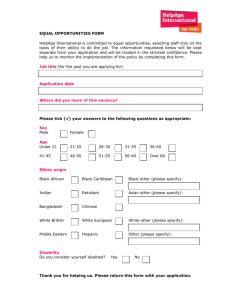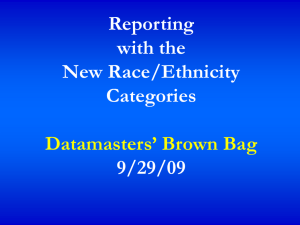Office of Diversity & Inclusion
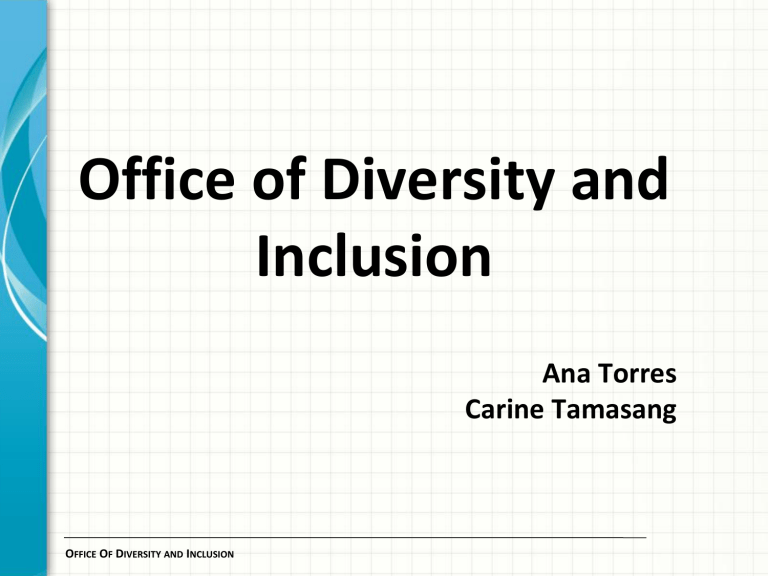
Office of Diversity and
Inclusion
Ana Torres
Carine Tamasang
O FFICE O F D IVERSITY AND I NCLUSION
Changing Demographics
People of Color will Comprise approximately 50% of the US Population in 2050!
Percent of People of Color
60,00%
50,00%
40,00%
30,00%
30,60%
34,90%
38,70%
42,50%
46,30%
49,90%
20,00%
2000
2010
2020
2030
2040
2050
10,00%
0,00%
2000 2010 2020 2030 2040 2050
Changing Demographics- Minorities
•
• 36.6% of the Labor Force
Management & Professional Positions
• 46.9% Asian American
• 29.2% African American
• 19.5% Latinos
Changing Demographics- Women
•
• 47% of the Labor Force
40.6% Management & Professional Positions
• 44.4% Asian American
• 34.1% African American
• 25.2% Latinas
Changing Demographics- Disabilities
•
•
36 Million or 12% of the U.S Population are disabled
20.7% of the Labor
Force
Education
•
13% of people with disabilities
25 and older have a bachelor's degree or higher compared to
31% percent for those with no disabilities.
Massachusetts Demographics
90,00%
80,00%
70,00%
60,00%
50,00%
40,00%
30,00%
20,00%
10,00%
0,00%
Black persons, percent, 2011
(a)
American
Indian and
Alaska Native persons, percent, 2011
(a)
Asian persons, percent, 2011
(a)
Native
Hawaiian and
Other Pacific
Islander persons, percent, 2011
(a)
Persons reporting two or more races, percent, 2011
Persons of
Hispanic or
Latino Origin, percent, 2011
(b)
White persons not Hispanic, percent, 2011
Massachusetts
USA http://quickfacts.census.gov/qfd/states/25000.html
Diversity at UMass Boston
•
41 percent of UMass Boston’s nearly 16,000 students are ethnic minorities or students of color, and they hail from more than 80 countries, making it the most diverse university in Massachusetts and one of the most diverse public universities in the United States.
•
In 2011 more than 40% of our new students reported their race or ethnicity as other than white/non-Hispanic.
•
In addition, 56% of our undergraduate and 69% of our graduate students are women.
Growing Body of Evidence
•
Campus diversity initiatives have positive effects on both minority and majority students. They improve students' relationships on campus and affect positively their satisfaction and involvement with their institutions and their academic growth.
•
Beyond their proven capacity to improve access and retention of underrepresented groups of students, comprehensive diversity initiatives also promote satisfaction, academic success, and cognitive development for all students.
• http://www.diversityweb.org/research_and_trends/research_evaluation_impact/benef its_of_diversity/impact_of_diversity.cfm
Link to University Mission
• In order to achieve the university's mission to "provide a supportive environment for students who represent many national and cultural origins," it is important for students to "see" themselves in the faculty and staff who serve them.
Link to University Mission
Students at UMass Boston
2011
0%
12%
American
Indian/Alaskan Native
Asian
16%
61%
11%
Black or African
American
Hispanic
0%
Hawaiian Native or
Pacific Islander
Staff at UMass Boston
2011
1%
8%
American
Indian/Alaskan Native
Asian
14%
Black or African
American
Hispanic
71%
6%
0%
Hawaiian Native or
Pacific Islander
Faculty at UMass Boston
2011
0%
9%
6%
3%
0%
American
Indian/Alaskan Native
Asian
Black or African
American
Hispanic
82%
Hawaiian Native or
Pacific Islander
Academic Challenges
•
Determining diversity needs
•
Creating a clear vision of intended achievements and their importance
•
Enhancing faculty and staff diversity
•
Hiring
•
Retention
•
Developing a business case for the diversity and inclusion strategy and securing buy-in from leadership
•
Buy in from middle management
•
Union leadership
•
Student leadership
•
Community
•
Creating a clear, quantifiable and achievable diversity and inclusion strategy and infusing it into every university function - making diversity a university-wide responsibility
•
Ensuring commitment at every level of the university.
•
Communicating the diversity strategy throughout the university , ensuring that students, faculty and staff understand the strategy and its benefits.
•
Transparent progress reports
•
Recruitment
•
Retention
•
Climate surveys
•
Understanding diversity as an everchanging dynamic, continually monitoring, reviewing, evaluating and revising the diversity strategy.
ODI Initiatives/Partnerships
•
Climate assessment
•
Diversity Dialogue o Diversity Week- Fall '13
•
UMB Film Series
•
Community outreach/partnerships
•
Personal Emergency Plan for people with disabilities
•
Diversity/Sexual harassment prevention/ADA training for UMB colleges/departments
Hiring Process- ODI Role
• During the hiring process ODI:
• approves search committee membership
• approves interview questions
• approves first round of candidates
• approves finalists
• approves finalist questions
• Access to the Position Posting
